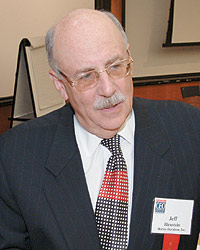Hog Wild
Kellogg School/BusinessWeek leadership forum gets revved up
with Harley-Davidson CEO
By Raksha Varma
 |
|
©
Evanston Photographic Studios
Jeff
Bleustein, Harley-Davidson CEO |
|
| |
|
|
|
|
| |
|
Harley-Davidson Inc. Chairman and CEO Jeffrey L. Bleustein
recently brought his leadership insights to the Kellogg School,
when he addressed the importance of attracting younger consumers
and running a market-based company during a special event
cosponsored by Kellogg and BusinessWeek.
"Harley-Davidson
stands for ‘Americana,’” said
Bleustein at the "CEO Leadership Forum with America’s
Best B-Schools.” James E. Ellis, chief of correspondents
for BusinessWeek, directed questions to Bleustein before
more than 100 attendees, including many Kellogg School
MBA students, at the Tribune Auditorium in the James
L. Allen
Center on the Evanston campus.
Bleustein fielded questions about why the
Harley-Davidson brand is vital to sustaining profitability. "Our
company’s brand is a promise to the consumer,” he
said. "We fulfill the dreams of our customers.
We aim to exceed their expectations.”
The
Harley-Davidson brand is targeted to 35- to 54-year-old
men, who comprise some 60 percent
of the company’s
consumer market, Bleustein noted. Although
Harley-Davidson is the leading American manufacturer
of motorcycles, Bleustein, who
joined the company in 1975,
said it took "a lifetime” to build the brand’s
reputation. "After I participated in the buyout, I
had my work cut out for me,” he said. "It
was risky at the time.” Despite the challenges posed by an 80-to-1
equity ratio and the 17.5 percent interest rate that existed
when the coup
was consummated, Bleustein and others managed to raise
$80 million to purchase Harley-Davidson in 1981 from its
parent
company, AMF.
"Bleustein
has clearly demonstrated that his career is not just
about taking risks,” said Karen Raviv, a first-year
Kellogg MBA student, who attended the forum. "It’s
about taking smart ones.”
Taking
a smart risk was clear in Bleustein’s choice
to include union input in Harley-Davidson’s decision-making
processes. He spoke about the importance of "working
together” with the unions to produce mutually beneficial
strategies.
"If
we include the unions in our decision, I know we can
boost productivity and generate more job security,” he
said.
With
the help of about 1,300 dealers, Harley-Davidson produced
more than 260,000 bikes
in 2002. The Electra
Glide, Sportster
and Fat Boy are three of the company’s 28 models. Bleustein
also spoke about the importance of producing marketing
strategies targeted to younger
customers. "Companies
should concentrate on strategies that appeal to Generation
X and Y,” he said. Harley-Davidson uses focus groups
to test the potential of future products. Programs such as "Rider’s
Edge” are offered by the company to educate some
11,000 new riders yearly.
"Our
company has adopted a long-term focus,” Bleustein
said. "Programs must have a clear connection to
the product line and future profitability.”
Bleustein ended the forum with highlights from Harley-Davidson’s 100th
anniversary, calling the milestone a "celebration of freedom.” |





